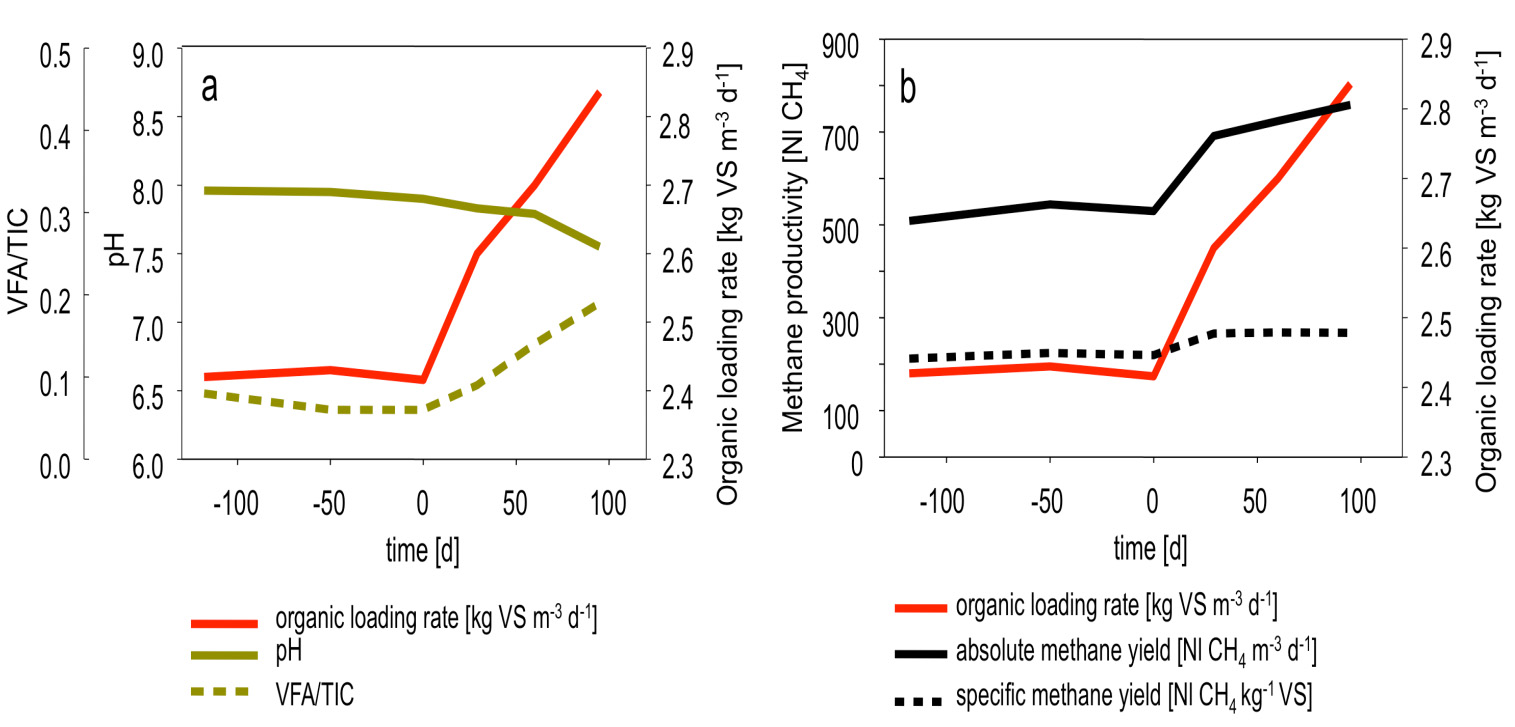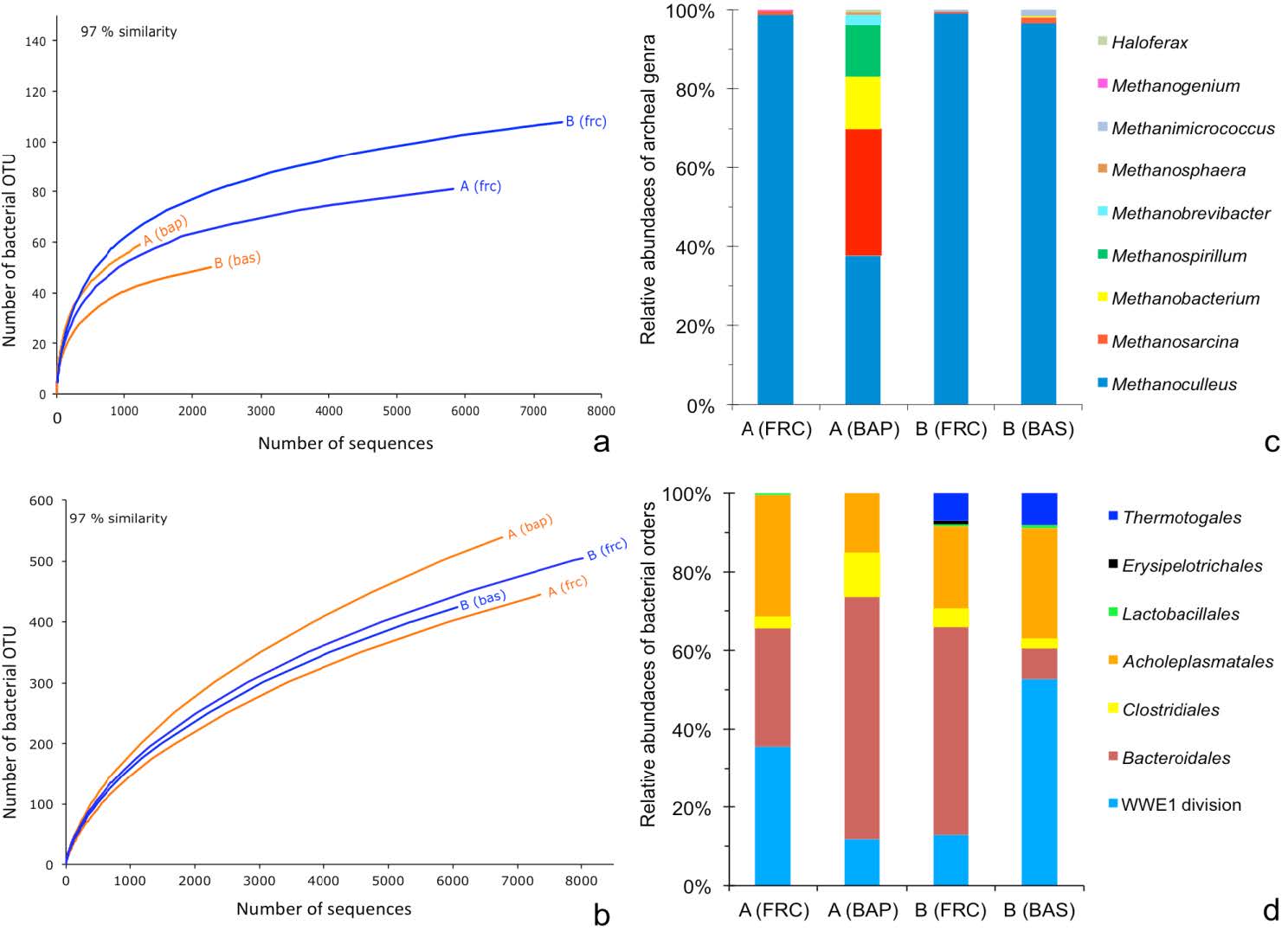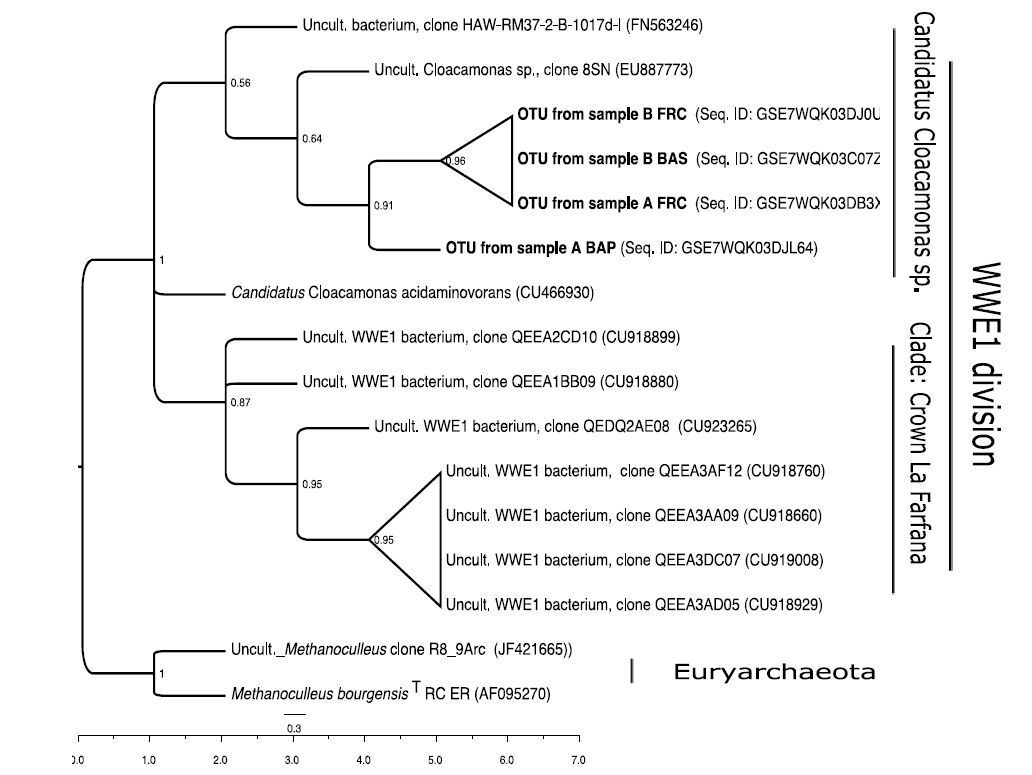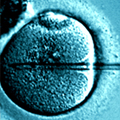1. Introduction
Anaerobic digestion(AD) of biowaste is often impaired by accumulation of volatile fatty acids (VFA).Under such conditions, the addition of biofilm carriers such as straw or sisal leaves has been shown to improve the performance of the biogas process [1,2]. The most important feature of food leftovers is a high-energy potential together with a low fiber content; this can lead to an unstable anaerobic process due to the lack of possibility for biofilm formation. Straw within structure-poor biowaste serves as biofilm carrier for microorganisms that may perform syntrophic metabolic exchange. An increase in biofilm growth could be beneficial in creating more stability and therefore enhancing the AD process. However, the microbial community attached to biofilm carriers in a waste-operating biogas reactor has never been analyzed directly by using molecular techniques targeting 16S rRNA genes. The biofilm mode of life offers advantages such as syntrophic interactions between microorganisms due to their physical vicinity [3]. Syntrophism is a special case of cooperation between two metabolically different types of microorganisms, which depend on each other for degradation of a certain substrate [4]. Microorganisms attached to a biofilm carrier form an extracellular polymeric substance (EPS) matrix [3]. This EPS matrix offers cells protection, provides mechanical stability and serves as a diffusion barrier for small molecules [5]. Biofilm formation was found to be a dynamic process that is correlated to biogas production. Moreover, biofilms contained more cells per ml (1011) compared to fluid reactor content (1010) in analyzed reactors [6]. As previously demonstrated, under certain conditions, syntrophic acetate-oxidizing bacteria and hydrogenotrophic methanogens are important members of a biogas-producing community [7,8].
Here we investigated a biogas reactor (350 m3) supplied with biowastes as the main reaction substrate. Despite the stable performance of the reactor overtime, the organic loading rate (OLR) was limited to a maximum of 2.4 kg VS m−3 d−1. When the OLR was increased above that, the biogas processbecame unstable due to accumulation of volatile fatty acids (VFA) (pers. communication by the operator). The aim of this study was to evaluate the effects of adding straw to the biogas reactor, as additional biofilms on straw may allow for higher OLR. Our hypotheses were that adding straw would allow improved biofilm formation and provide a suitable habitat for syntrophic degradation of VFAs, with these benefits mirrored by changes in the microbial community. To that end, the reactor performance was recorded before and after straw addition and the microbial community structure associated with chopped straw was compared with the community structure in the fluid reactor content.
2. Materials and Method
2.1. Reactor operation and sampling
The biogas plant with straw addition consisted of three stirred reactors in sequence of 350,450, and 1200 m3 volume, operating at 40 °C with an installed electrical output capacity of 380 kWh [9]. The plant, which is located in Southern Germany near Aulendorf in Baden-Württemberg, utilized predominantly sanitized food residues and was operated by a local farmer. The total reactor volume of 2000 m3 was operated at a mean hydraulic residence time (HRT) of 67 days. For construction reasons, pig slurry was fed directly to reactor 1 (350 m3) while other substrates could be supplied independently to each of the reactors. For the described experiments the amount of biowaste fed to reactor 1 was experimentally modified in order to test the effect of straw addition while increasing the OLR. Substrates constantly fed to this reactor were sanitized food residues (19% total solids (TS), 92% volatile solids (VS), 3.9 pH, C/N ratio 14:1) and stale bread (65% TS, 96% VS) in variable compositions. Agricultural residues such as pig slurry (4% TS, 64% VS) were the other major constituents constantly fed. Further substrates namely maize silage, and potato peelings were supplied in minor and variable proportions according to unsteady availability. The food leftovers were residues from commercial kitchens or factory canteens. In Germany it is mandatory that food leftovers used in biogas reactors were previously pasteurized (70 °C, 1 h) and homogenized by an accredited waste management company (Pig Food GmbH, Aulendorf, Germany). The slurry (usually pH of 3.7) was delivered to the biogas plant.
Wheat straw (320 kg every 14 days, 0.5% of the reactor content, fresh mass) was added to reactor 1 (day 0, Figure 1), which theoretically increased the OLR by 0.06 kg m−3 day−1. In order to enumerate the effects on reactor performance, key production data were analyzed 100 days in advance and after the supplementation of straw (Figure 1b). Reactor 1 fed with biowaste and pig slurry had an average HRT of 35 days. A gas flow meter (Binder Inc., Germany) implemented in the gas outlet measured the biogas produced in this reactor continuously. Thus, performance of reactor 1 was documented.
Samplings for microbial investigations were drawn just before straw was added to the biogas reactor 1 (sample A). After 21 days of fermentation, sample B was taken from the same reactor. The 21 day period was seen as appropriate to obtain full-developed biofilms [6,10]. The fluid reactor content (FRC) of sample A and B was filtered by a sieve (mesh 1mm), and the microbial biomass attached to particles (BAP) from sample A, as well as biomass attached to straw (BAS) from sample B was removed with sterile swabs. In total, 1 g of fresh cell suspension was collected for further use from each sample. Before the addition of straw, barely 0.5% of the reactor content (fresh weight) were particles greater than 1 mm (sample A). The microbial composition of BAP of sample B was not analyzed.
2.2. Total community DNA preparation and amplicon sequencing
In order to extracttotal DNA, sample washing and cell lysis procedures were performed as described previously [11] with slight modifications. Additional cell disruption steps such as homogenization, freezing (−80 °C, 15 min), and thawing (95 °C, 15 min) were included [12]. Thereafter, the total DNA was extracted following the manufacturer’s protocol of the 'High Pure PCR Template Preparation Kit' (Roche, Mannheim, Germany). The primers used to amplify archaeal and bacterial 16S rRNA genes were tagged by barcodes (one barcode for each sample) and synthesized by biomers.net GmbH (Ulm, Germany). Therefore, barcoded primers (BSF8 and BSR357) were used to amplify the bacterial V2-V3 region (350 bp) of 16S rRNA gene fragments [13]. Similarly, barcoded primers (SAf1, and PARCH519r) were used to amplify archaeal 16S rRNA gene fragments (200 bp) [14]. 16S rRNA genes were amplified from each sample by three independent PCR reactions using the High Fidelity PCR Enzyme Mix (Fermentas, St. Leon-Rot, Germany). Temperature steps for bacterial 16S rRNA genes were 98 °C for 5 min, a loop of 10 cycles of 95 °C for 1 min, 55 °C for 45 s, and 72 °C for 1 min, 20 cycles of 95 °C for 1 min, 59 °C for 30 s, and 72 °C for 1 min, and a final incubation at 72 °C for 10 min. Temperature steps for archaeal 16S rRNA genes were 98 °C for 5 min, 10 cycles of 98 °C for 45 s, 53.5 °C for 45 s, and 72 °C for 1 min, 20 cycles of 95 °C for 30 s, 55 °C for 30 s, and 72 °C for 1 min, and a final incubation at 72 °C for 10 min. Thereafter, 16S rRNA gene fragments were purified separately using the 'NucleoSpin® Extract II Kit' (Macherey-Nagel, Düren, Germany), and finally combined in equimolar amounts for pyrosequencing. The procedure was carried out by LGC Genomics (Berlin, Germany) using the GS-FLX TITANIUM 454 Pyrosequencer (Roche, Mannheim, Germany). Obtained data were processed using the RDP’s Pyrosequencing Pipeline [15]according the 16S unsupervised workflow. Bacterial and archaeal 16SrRNA gene sequences were deposited in the ENA Sequence Read Archive under accession number PRJEB4407.
3. Results and Discussion
3.1. Reactor performance
The performance of the biogas process in reactor 1 was improved by the addition of straw, while the OLR of biowaste could be increased from 2.4 to 2.8 kg VS m−3 d−1. Under previous conditions (no additional straw), such an increase of the ORL was not possible, without unbalancing the biogas process (pers. communication by the operator). Subsequently, absolute methane yield was enhanced by 230 Nl m−3 d−1 and specific methane yield increased by 50 Nl kg−1 VS (Figure 1b).
Thereby, electrical power output was increased by about 50 kW. As a further result of the increased OLR, the VFA/TIC ratio of the reactor content reached a value of 0.19 and a pH value of 7.5 (Figure 1a). The concentration of VFA in reactor 1 was approximately 4.1 (day 0) and 4.9 g L−1 (day +100). Acetate concentration increased from 3.1 to 4.1 g L−1 whereas propionate slightly decreased. Total ammonia and ammonium concentrations (NH3 + NH4+) ranged from 4.5 (day 0), 10.4 (day +21) up to 13.3 g NH4+-N L−1 (day + 27). The calculated [16] free ammonia concentrations ranged from 0.5, 0.85, and 0.7 (g NH3-N L-1), respectively.
Despite these high nitrogen loads, no signs of ammonia-related process inhibition were observed. Koster and Lettinga [17]reported previously, that microbial communities in AD processes exposed to similar ammonia concentrations also had a high adaptation potential to high nitrogen loads. An additional amount of biogas due to strawaddition is negligible. The daily dose of straw of only 23 kg increases the organic loading rate just by 0.06 kg m−3 d−1 compared to total increase of OLR by 0.4 kg VS m−3 d−1 (biowaste).
3.2. Diversity profiles of microbial communities
Species richness estimated from archaeal and bacterial 16S rRNA gene sequences with a homology of 97% are shown in Table 1. At 97% homology, the Shannon index for archaeal 16S rRNA gene sequences ranged from 2.14 to 2.84 (Table 1A). In contrast, for bacterial 16S rRNA gene sequences these values were higher and ranged from 3.11 to 3.83 (Table 1B). Similar numbers for archaea and bacteria were determined for a solid-state AD by terminal restriction fragment length polymorphism analysis [18]. The rarefaction analysis of archaeal communities showed saturated curves (Figure2a) and 75 operationaltaxonomic units (OTUs) on average. Additionally, the estimated taxonomic richness was covered by 63.3 to 87.9% based on the values given by the Chao1 richness estimator (Table 1A). The rarefaction curves of bacterial communities revealed no saturation (Figure2b) and 478 OTUs on average. The estimated richness was covered by 56.4 to 70% (Table 1B), respectively. The average archaeal OTUs (75) was 6.4 times lower compared to the corresponding number of bacterial OTUs. In a solid-state biogas reactor Li et al. [18] recently found similar OTU values. Martínez et al. [19] reported somewhat lower OTU numbers using a 16S rRNA gene amplicon approach to analyze the microbial community of an up flow anaerobic sludge blanket type reactor.
Table 1. Species richness estimated from archaeal (A) and bacterial (B) 16S rRNA gene sequences at 97% homology.
|
Sample
|
Shanon index (H') a
|
Rarefaction b
|
Chao1 c
|
Coverage (%)
|
|
A: archaeal 16S rRNA gene sequences
|
|
A FRC
|
2.41
|
81
|
102.8
|
78.8
|
|
A BAP
|
2.84
|
59
|
93.2
|
63.3
|
|
B FRC
|
2.34
|
108
|
133
|
81.2
|
|
B BAS
|
2.14
|
50
|
56.9
|
87.9
|
|
B: bacterial 16S rRNA gene sequences
|
|
A FRC
|
3.11
|
443
|
723
|
61.2
|
|
A BAP
|
3.76
|
539
|
954
|
56.4
|
|
B FRC
|
3.83
|
504
|
719
|
70.0
|
|
B BAS
|
3.55
|
424
|
670
|
63.2
|
a A higher number indicates a higher diversity.
b The results from the rarefaction analyses are also shown in Figure2a and Figure2c.
cNonparametric richness estimator based on the distribution of singletons and doubletons. |
The most abundant archaea in all samples were classified to the genera Methanoculleus and Methanosarcina (Figure2c). The FRC samples before and after the addition of straw as well as the BAS samples were dominated by archaea of the genus Methanoculleus (order Methanomicrobiales, 99 % abundance per sample). The composition of the archaeal community of BAP differed from those samples. It was dominated by archaea of the genera Methanosarcina (order Methanosarcinales, 32.7%) and Methanoculleus (51.2%). Moreover, different genera of the order Methanobacteriales (15.5%) were also present in this sample.
The most prevalent bacteria in all samples belonged to the following orders: Acholeplasmatales, Bacteroidales, Clostridiales, Thermotogales, and a so far uncultured bacterium of the division WWE1 (Figure 2d). These bacterial orders were also abundant in other biogas reactors [18,19,20]. Before addition of straw (sample A), the FRC subsample was dominated by the WWE1-bacterium (35%). Furthermore, bacteria belonged to the genus Acholeplasma (Acholeplasmatales, 30%) and to different bacteria of the order Bacteroidales (30.2%). Most bacteria associated to BAP were classified as Bacteroidales (61.8%), others as Acholeplasma (15.2%), and the WWE1-bacterium (11.8%). After addition of straw (sample B), the bacterial composition of FRC was still dominated by the same bacteria as for sample A. However, abundances of the WWE1-bacterium and the Acholeplasma-bacterium decreased, whereas abundance of bacteria of the order Bacteroidalesincreased. The bacterial community on the straw-based biofilms (BAS) was highly dominated by the WWE1-bacterium (52.6%), which was far more abundant compared to WWE1 in the FRC of the same sample (13.0%) and on BAP of sample A (11.8%). The second most abundant genus in BAS samples was Acholeplasma. Lower abundances of bacteria of the orders Bacteroidales and Thermotogales (both 8%) were also present. Although not specifically analyzed, the microbial community of BAP could have changed to become similar to the BAS community composition during the 21 days of fermentation between samples A and B.
An overview of classified archaea and bacteria is shown in Table 2A and Table 2B,respectively. Many OTUs assigned to the bacterial order Bacteroidales and Clostridiales could not be further classified down to family or genus level (indicated by uncultured). Only few OTUs were assigned down to genus level and include species from the genera belonging to Clostridium, Petrotoga, Proteiniphilum, Streptococcus, and Turicibacter (Table 2B).
Table 2. Classified archaea (A) and bacteria (B) from 16S rRNA gene sequences. Sample A: before the addition of straw; sample B: after the addition of straw; FRC: fluid reactor content; BAP: biofilm attached to particles (> 1 mm); BAS: biofilm attached to straw.
|
Sample
|
Phylum [%]
|
Order [%]
|
Family [%]
|
Genus [%]
|
|
A: archaeal 16S rRNA gene sequences
|
|
A (FRC)
|
|
Methanomicrobiales (99.1)
|
Methanomicrobiaceae (99.1)
|
Methanoculleus sp. (98.7)
|
|
|
|
|
|
Methanogenium sp. (0.4)
|
|
|
|
Methanosarcinales (0.9)
|
Methanosarcinaceae (0.9)
|
Methanosarcina sp. (0.9)
|
|
A (BAP)
|
|
Halobacteriales (0.6)
|
Halobacteriaceae (0.6)
|
Haloferax sp. (0.6)
|
|
|
|
Methanobacteriales (15.5)
|
Methanobacteriaceae (16.3)
|
Methanobrevibacter sp. (2.4)
Methanobacterium sp. (13.2)
Methanosphera sp. (0.7)
|
|
|
|
Methanomicrobiales (51.2)
|
Methanomicrobiaceae (37.7)
Methanospirillaceae (13.1)
|
Methanoculleus sp. (37.7)
Methanospirillum sp. (13.1)
|
|
|
|
Methanosarcinales (32.3)
|
Methanosarcinaceae (32.3)
|
Methanosarcina sp. (32.3)
|
|
B (FRC)
|
|
Methanomicrobiales (99.0)
|
Methanomicrobiaceae (99.0)
|
Methanoculleus sp. (99.0)
|
|
|
|
Methanosarcinales (1.0)
|
Methanosarcinaceae (1.0)
|
Methanosarcina sp. (0.5)
|
|
|
|
|
|
Methanimicrococcus sp. (0.5)
|
|
|
|
Methanobacteriales (0.3)
|
Methanobacteriaceae (0.3)
|
Methanobacterium sp. (0.3)
|
|
B (BAS)
|
|
Methanomicrobiales (97.0)
|
Methanomicrobiaceae (96.7)
|
Methanoculleus sp. (96.7)
|
|
|
|
|
Methanospirillaceae (0.3)
|
Methanospirillum sp. (0.3)
|
|
|
|
Methanosarcinales (2.7)
|
Methanosarcinaceae (2.7)
|
Methanosarcina sp. (1.4)
|
|
|
|
|
|
Methanimicrococcus sp. (1.3)
|
|
B: bacterial 16S rRNA gene sequences1
|
|
A (FRC)
|
Bacteroidetes (30.2)
|
Bacteroidales (30.2)
|
uncult. Porphyromonadaceae (30.2)
|
n. f. c2
|
|
|
Firmicutes (3.2)
|
uncult. Clostridiales (2.8)
|
n.f.c2
|
n. f. c2
|
|
|
|
Lactobacillales (0.4)
|
Streptococcaceae (0.4)
|
Streptococcus sp. (0.4)
|
|
|
Tenericutes (30.0)
|
Acholeplasmatales (30.0)
|
Acholeplasmataceae (30.0)
|
Acholeplasma sp. (30.0)
|
|
|
WWE1 division (35.6)
|
n. n. a.3
|
n. n. a. 3
|
Candidatus C. acidaminovorans (35.6)
|
|
A (BAP)
|
Bacteroidetes (61.8)
|
Bacteroidales (20.2)
uncult. Bacteroidales (41.6)
|
uncult. Porphyromonadaceae (20.2)
n. f. c2
|
n. f. c2
n. f. c2
|
|
|
Firmicutes (11.2)
|
Clostridiales (11.2)
|
Clostridiaceae (3.4)
uncult.Ruminococcaceae (7.8)
|
Clostridium sp. (3.4)
n. f. c2
|
|
|
Tenericutes (15.2)
|
Acholeplasmatales (15.2)
|
Acholeplasmataceae (15.2)
|
Acholeplasma sp. (15.2)
|
|
|
WWE1 divison (11.8)
|
n. n. a. 3
|
n. n. a. 3
|
Candidatus C. acidaminovorans (11.8)
|
|
B (FRC)
|
Bacteroidetes (52.0)
|
Bacteroidales (52.0)
|
Porphyromonadaceae (4.1)
uncult. Porphyromonadaceae (47.9)
|
Proteiniphilum sp. (4.1)
n. f. c2
|
|
|
Firmicutes (6.0)
|
Clostridiales (4.6)
|
Clostridiaceae 1 (4.6)
|
Clostridium sp. (4.6)
|
|
|
|
Erysipelotrichales (0.8)
|
Erysipelotrichaceae (0.8)
|
Turicibacter sp. (0.8)
|
|
|
|
Lactobacillales (0.6)
|
Streptococcaceae (0.6)
|
Streptococcus sp. (0.6)
|
|
|
Tenericutes (21.0)
|
Acholeplasmatales (21.0)
|
Acholeplasmataceae (21.0)
|
Acholeplasma sp. (21.0)
|
|
|
Thermotogae (7.0)
|
Thermotogales (7.0)
|
Thermotogaceae (7.0)
|
Petrotoga sp. (7.0)
|
|
|
WWE1division (13.0)
|
n. n. a. 3
|
n. n. a. 3
|
Candidatus C. acidaminovorans (13.0)
|
|
B (BAS)
|
Bacteroidetes (8.0)
|
uncult. Bacteroidales (8.0)
|
n. f. c2
|
n. f. c2
|
|
|
Firmicutes (3.4)
|
uncult. Clostridiales (2.4)
|
n. f. c2
|
n. f. c2
|
|
|
|
Lactobacillales (1.0)
|
Streptococcaceae (1.0)
|
Streptococcus sp. (1.0)
|
|
|
Tenericutes (28.0)
|
Acholeplasmatales (28.0)
|
Acholeplasmataceae (28.0)
|
Acholeplasma sp. (28.0)
|
|
|
Thermotogae (8.0)
|
Thermotogales (8.0)
|
Thermotogaceae (8.0)
|
Petrotoga sp. (8.0)
|
|
|
WWE1 divison (52.6)
|
n. n. a. 3
|
n. n. a. 3
|
Candidatus C. acidaminovorans (52.6)
|
| 1 bacterial sequenced classified only on domain level accounted for 1 % per sample; 2 n.f.c, no further classification; 3 n. n. a, no name assigned;
|
Highly abundant bacterialstrains classified as Acholeplasma and WWE1-bacterium presumably play an important role for AD of biowaste and were also found in another biogas reactor [21]. Acholeplasma is a genus of the family Acholeplasmataceae (order Acholeplasmatales, class Mollicutes). Most Mollicutes are facultative anaerobic chemoorganotrophs which utilize sugars as their main energy sources [22]. All Mollicutes so far studied exhibit reduced respiratory systems. They have an incomplete tricarboxylic acid cycle and no quinones or cytochromes. According to the known energy-yielding pathways of Mollicutes, ATP is generated in low yields and rather large quantities of acidic metabolic end products are produced [23]. These end products may negatively affect process stability if not immediately degraded, which is the case in syntrophic communities. A phylogenetic tree (Figure 3) was reconstructed [9]based on bacterial 16S rRNA gene sequences of the WWE1 division. The upper clade of the phylogenetic tree contained OTUs of the sample BAS and is related to the uncultured bacterium Candidatus Cloacamonas acidaminovorans. Other 16S rRNA gene sequences of the WWE1 division in the lower branch were unified as an artificial clade called Crown La Farfana. The uncultured bacterium Candidatus C. acidaminovorans was described as possiblysyntrophic and present in many anaerobic digesters [24]. The straw-attached biofilms (BAS sample) were dominated by the microorganisms Candidatus C. acidaminovorans and Methanoculleus sp. (Figure 2c and d). In silico proteome analysis indicated that Candidatus C. acidaminovorans might derive most of its carbon and energy from the fermentation of amino acids (
important for detoxifying the nitrogen-rich biowaste AD) and oxidative propionate degradation, thereby hydrogen and CO2 are produced. Close by, within the biofilm, hydrogenotrophic methanogenic archaea of the genus Methanoculleus [25]could act as a syntrophic partner for Candidatus C. acidaminovorans. Interactions between both partners in the biofilms would likely keep the concentration of propionic acid low, which is a prerequisite for a stable AD process. Remarkably, in the full-scale reactor subjected to this study, the propionate concentration decreased after straw addition despite of slightly increased total concentration of organic acids.
At present, few studies demonstrated that bacteria of the WWE1 division and hydrogenotrophic archaea are present in anaerobic digesters [20,26]. Fotidis et al. [8] found that syntrophic acetate oxidation (SAO) coupled with hydrogenotrophic methanogenesis was the dominant pathway in digesters with high ammonia levels. Similarly, Sun et al. [27] showed that a high abundance of microorganisms involved in SAO was positively correlated to relatively low abundance of acetoclastic methanogens and high concentrations of free ammonia and VFA. These findings are in accordance with our results regarding high ammonia concentration and higher abundances of presumable syntrophic microbes in biofilms on straw compared to the fluid biogas reactor content (Figure2d). Syntrophic interaction of VFA oxidizing bacteria and hydrogen-consuming methanogens associated in biofilms on straw is presumably the cause for the mentioned positive influence of straw on the biogas-forming process[1,2,28]. The mic
robial community attached to straw uses the advantages of building up biofilms in a solid-liquid interface. Within the EPS matrix, high cell densities and cell-cell recognition [3] may lead to specialized microbial interactions dominated by Methanoculleus having a direct use of the bacteria-produced H2 and CO2. Such interactions would explain the mentioned positive influence of straw on the biogas-forming process utilizing food residues.
4. Conclusion
In summary the major impacts of chopped straw as biofilm carrier on the biogas process performance have been: (1) increased OLR without process stability impairment, (2) increased specific methane yield, and thus (3) higher total energy output. As a result of this successful experiment, the biogas plant owner is still adding fiber-rich plant material to the AD process and the reactor has been operating without failure since 2011. Thus, AD of food residues in a full-scale biogas reactor was improved by addition of straw. Already slight amounts of straw allowed an increase of the organic loading by protein-rich biowaste. Due to presumed syntrophic interaction between protein- as well as VFA- degrading bacteria and hydrogenotrophic archaea, it was possible to increase methane production without impairing process stability. Straw has outstanding properties as an additive for biogasproduction by fermentation of low structural content residues. Due to its natural origin it is preferable to artificial biofilm carriers because it is disposable together with the digestate.
Acknowledgments
We are obliged to the Baden-Württemberg Foundation, for financing this study within the Biomass to Energy program (Project No, Bio 06). We thank Prof. P. Dürre, Institute of Microbiology and Biotechnology, Ulm University for providing laboratory space. We are also thankful to Mr. A. Allgayer for providing access to his biogas plant.
Conflict of Interest
The authors declare no conflict of interest.










 DownLoad:
DownLoad: 







